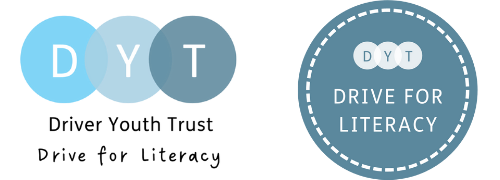#PositiveDyslexia Part 1: Dyslexia & Self Perception
5/10/2017
DYT Consultant Teacher Nancy Gedge reflects on Dyslexia Awareness Week and how teachers can embody and implement #PositiveDyslexia2017 in the classroom…

Dyslexia Awareness Week is a time to celebrate the endeavour of people with literacy difficulties and their perseverance, particularly in education. This year’s theme of Dyslexia Awareness Week is “positive dyslexia” and here at DYT, we have been thinking about what this means for the children and young people in school today, in 2017.
There is considerable research literature around the self-perception of SEND young people, (Glazzard, 2010, DfE, 2017) which points towards self-concept, that is, the image we have of ourselves as people – and in school, as learners – as an important part of achieving success. In simple terms, when we believe in ourselves, our ability to take on new challenges increases.
The confusion and distress felt by dyslexic children and their families is well documented, as is, increasingly, the role that teachers play in helping children understand their difficulties, and work towards overcoming them, while maintaining that essential positive view of themselves as people who can achieve and learn.
So, what can teachers do? Here at DYT we have put together a two-part series of blogs on how teachers can help dyslexic children and young people be positive about dyslexia.
Bear in mind that children become increasingly aware, from around age 8, of their ‘rank order’. (Gurney, 1988)
Reducing the amount of value you attach to academic rankings is hard for a teacher whose pay depends on children’s achievements in the classroom, and whose job is essentially about academic learning. With moves in assessment towards a model of comparative judgement, ‘ranking’ is likely to be at the forefront of a teachers mind. Ability setting, grouping or streaming all contribute to an outward awareness of attainment, especially if teachers use such groupings as an organisational feature of their classroom.
Teachers can, however, through modelling, show that there is much more to be valued in a person than the academics. They can remind children that an education is a journey of discovery, and look for opportunities where children excel – in whatever area – and celebrate it.
Use your own experiences
It is rare to find an adult who has had little experience of struggle in every area of their lives. Dyslexic teachers have a deep understanding of what dyslexic learners are going through and how to help them (Glazzard & Dale, 2013), but this doesn’t mean that typical teacher cannot empathise, or find the same ways to support them.
Think about a time when you found something really hard, especially if it was at school. What was it that helped you? What did you do to effect change? Think about the principles behind the actions, and see if you can apply them elsewhere. Be honest with your classes about when you find/found things hard.
Be a role model
We don’t advocate the making of deliberate mistakes, but showing your class those moments when you need to look something up, when you use technology or other aids to help you, and, when you make a mistake, how you recover from it, are positive messages to send all children, especially those with some form of learning difficulty or disability (Gedge, 2016).
Actively demonstrating that humans are not perfect and that you can be imperfect and still experience success is a powerful lesson, especially for those who may have internalised an idea that they are somehow ‘wrong’ in themselves.
Drive for Literacy
Raising academic standards for learners is the raison d’etre for all schools, and we believe that SEND learners are an essential part of this picture. Our flagship programme, Drive for Literacy (DfL), is a collaboration between policy and practice and is informed by the evidence of our research. It is a whole school model for literacy, built around the Graduated Approach and starting from Quality First Teaching. Its aim is to build teacher capability and school capacity to identify and support learners who struggle with reading, writing, speaking and listening.
Any learning difficulty or disability makes life in school more challenging, but this doesn’t mean that dyslexic learners, or any other kind of SEND learner for that matter, has to feel negative about themselves. #positivedyslexia gives us all a chance to reflect on what we can do to enable young people to believe in themselves and face their futures, and future challenges, with resilience.
Keep your eyes peeled for Part 2 which will cover more ways in which teachers can encourage positive self perception in children with dyslexia…
References
Department for Education (2017) The wellbeing of secondary school pupils with SEN, https://www.gov.uk/government/publications/the-wellbeing-of-secondary-school-pupils-with-sen
Equality Act (2010) Part 2: Equality: Key Concepts, National Archives, http://www.legislation.gov.uk/ ukpga/2010/15
Burns, E. & Bell, S. (2011) ‘Narrative construction of professional teacher identity of teachers with dyslexia.’ Teachers and Teaching: Theory and Practice, 27, pp. 952–60
Butkowsky, L. S. & Willows, D. M. (1980) ‘Cognitive-motivational characteristics of children varying in reading ability: evidence for learned helplessness in poor readers.’ Journal of Educational Psychology, 72 (3), pp. 408–22.
Chan, L. K. S. (1994) ‘Relationship of motivation, strategic learning and reading achievement in grades 5, 7 and 9.’ Journal of Experimental Education, 62 (4), pp. 319–39
Gedge, N (2016) ‘Inclusion for Primary School Teachers’ London: Bloomsbury
Glazzard,J & Dale,K (2013) ‘Trainee teachers with dyslexia: personal narratives of resilience’ Journal of Research in Special Educational Needs 13 (1), pp26–37
Glazzard, J. (2010) ‘The impact of dyslexia on pupils’ self-esteem.’ Support for Learning, 25 (2), pp. 63–9.
Gurney, P. W. (1988) Self-Esteem in Children with Special Educational Needs. London: Routledge.
Humphrey, N. & Mullins, P. (2002b) ‘Personal constructs and attribution for academic success and failure in dyslexia’.’ British Journal of Special Education, 29 (4), pp. 196–203.
Oliver, M. (1996) Understanding Disability: From Theory to Practice. Basingstoke, UK: Macmillan.
